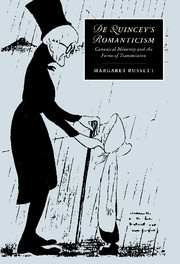Book contents
- Frontmatter
- Contents
- Acknowledgments
- List of abbreviations
- Introduction
- 1 Conversions: Wordsworth's gothic interpreter
- 2 Transmissions: composing The Convention of Cintra
- 3 Impersonations: the magazinist as minor author
- 4 Reproductions: opium, prostitution, and poetry
- 5 Appropriations: the counter-lives of the poet
- Epilogue: minor Romanticism
- Notes
- Index
- CAMBRIDGE STUDIES IN ROMANTICISM
1 - Conversions: Wordsworth's gothic interpreter
Published online by Cambridge University Press: 26 October 2011
- Frontmatter
- Contents
- Acknowledgments
- List of abbreviations
- Introduction
- 1 Conversions: Wordsworth's gothic interpreter
- 2 Transmissions: composing The Convention of Cintra
- 3 Impersonations: the magazinist as minor author
- 4 Reproductions: opium, prostitution, and poetry
- 5 Appropriations: the counter-lives of the poet
- Epilogue: minor Romanticism
- Notes
- Index
- CAMBRIDGE STUDIES IN ROMANTICISM
Summary
DE QUINCEY PERSONIFIES “WE ARE SEVEN”
Halfway through his revised Confessions, De Quincey pauses to ask a rhetorical question – “Was I then, in July 1802, really quoting from Wordsworth?” – and stays to answer, “Yes, reader; and I only in all Europe. In 1799 I had become acquainted with ‘We are Seven’ at Bath” (M 3:302). De Quincey's question and his response characteristically link grandiose posturing with a memory of reading, through apostrophe to the surrogate of his own early wonder. Equally characteristic is the bathetic following sentence, in which he names the poem he read and specifies the date and place of his first acquaintance with it. These details anchor the constitutive De Quinceyan claim that, simply by quoting Wordsworth, he had “taken up one position in advance of my age by full thirty years” (R 116). Like a leading from above, “We Are Seven” catalyzes “the unfolding of” De Quincey's “own mind” (R 33), as though the encounter described in the poem, where a man interrogates “a little cottage girl” (LB 66:5), represented a discovery of vocation. Thus the De Quinceyan reader, wise “by one entire generation” (R 118), converts youth and solitude into rhetorical advantage. De Quincey stakes his place in literature on a historical circumstance he interprets as accelerated “intellectual development” (R 116): the precocity of a fourteen-year-old who can already read “We Are Seven.”
- Type
- Chapter
- Information
- De Quincey's RomanticismCanonical Minority and the Forms of Transmission, pp. 14 - 51Publisher: Cambridge University PressPrint publication year: 1997

